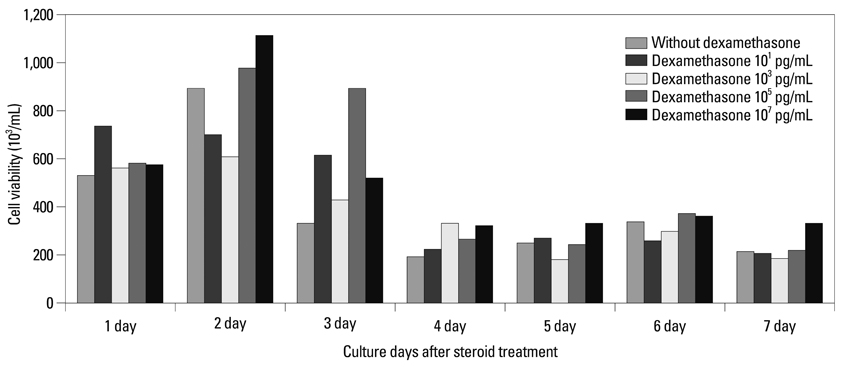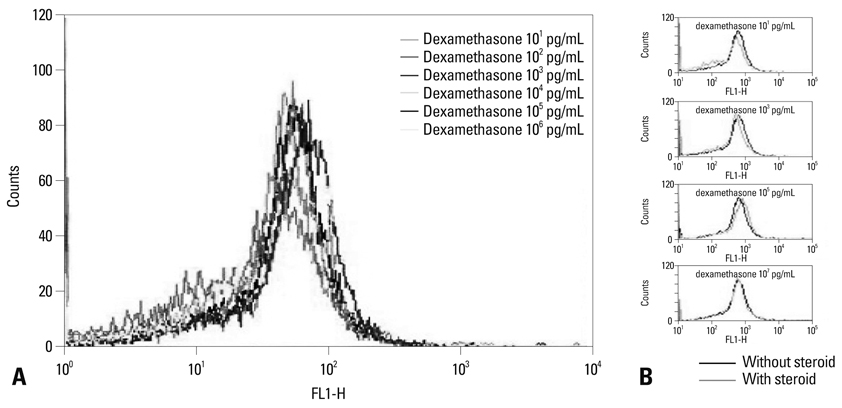Yonsei Med J.
2011 Jul;52(4):624-629. 10.3349/ymj.2011.52.4.624.
Lack of Effect of Dexamethasone on Growth of Orientia Tsutsugamushi Gilliam in Mouse L929 Cells
- Affiliations
-
- 1Department of Internal Medicine and AIDS Research Institute, Yonsei University College of Medicine, Seoul, Korea. jmkim@yuhs.ac
- 2Department of Internal Medicine, National Health Insurance Corporation Ilsan Hospital, Goyang, Korea.
- 3Department of Internal Medicine, Kangbuk Samsung Hospital, Sungkyunkwan University School of Medicine, Seoul, Korea.
- 4Department of Internal Medicine, Kwandong University Myongji Hospital, Kwandong University College of Medicine, Goyang, Korea.
- KMID: 1727995
- DOI: http://doi.org/10.3349/ymj.2011.52.4.624
Abstract
- PURPOSE
Previous studies and our own clinical experience suggest that concurrent corticosteroid treatment for severe rickettsial disease with multiorgan failure may improve the clinical course or reduce mortality. However, the use of corticosteroids as adjunctive treatment for rickettsial diseases is controversial. We attempted to determine the influences of corticosteroid on the growth of Orientia tsutsugamushi in vitro to justify and evaluate the clinical applicability of corticosteroid in rickettsial disease.
MATERIALS AND METHODS
L929 cells were infected with Orientia tsutsugamushi Gilliam. Dexamethasone was added to the cells at final concentrations of 10(1) and 10(7) pg/mL. Cultures were incubated at 35degrees C and processed for flow cytometry on the 6th day after addition of dexamethasone.
RESULTS
Observation on the 6th day after treatment with dexamethasone in infected cultures revealed that there was no difference in fluorescence intensity among the treatment wells. Treatment of the cells with dexamethasone at concentrations of 10(1) and 10(7) pg/mL showed no influence on the growth of Orientia tsutsugamushi.
CONCLUSION
Our results to show that isolated corticosteroid does not enhance the replication of Orientia tsutsugamushi in vitro. Concurrent use of anti-inflammatory or immunosuppressive doses of corticosteroids in conjunction with antibiotics may not have detrimental effects on the course of scrub typhus.
MeSH Terms
Figure
Reference
-
1. Tamura A, Takahashi K, Tsuruhara T, Urakami H, Miyamura S, Sekikawa H, et al. Isolation of Rickettsia tsutsugamushi antigenically different from Kato, Karp and Gilliam strains from patients. Microbiol Immunol. 1984. 28:873–882.
Article2. Jerrells TR, Turco J, Winkler HH, Spitalny GL. Neutralization of lymphokine-mediated antirickettsial activity of fibroblasts and macrophages with monoclonal antibody specific for murine interferon-gamma. Infect Immun. 1986. 51:355–359.
Article3. Hanson B. Susceptibility of Rickettsia tsutsugamushi Gilliam to gamma interferon in cultured mouse cells. Infect Immun. 1991. 59:4125–4133.
Article4. Breitschwerdt EB, Davidson MG, Hegarty BC, Papich MG, Grindem CB. Prednisolone at anti-inflammatory or immunosuppressive dosages in conjunction with doxycycline does not potentiate the severity of Rickettsia rickettsii infection in dogs. Antimicrob Agents Chemother. 1997. 41:141–147.
Article5. Workman FB, Hightower JA, Borges FJ, Furman JE, Parker RT. Cortisone as an adjunct to chloramphenicol in the treatment of Rocky Mountain spotted fever. N Engl J Med. 1952. 246:962–966.
Article6. Choi HC, Wie SH, Lee SY, Kim SI, Park SK, Jung YJ, et al. Use of high-dose steroid in a case of scrub typhus with acutely progressive local neurologic symptoms. Korean J Infect Dis. 2002. 34:391–395.7. Hansen MB, Nielsen SE, Berg K. Re-examination and further development of a precise and rapid dye method for measuring cell growth/cell kill. J Immunol Methods. 1989. 119:203–210.
Article8. Tasneen R, Yoshiie K, Ohkawa T, Oda H. High concentration of recombinant murine interferon-beta enhances the growth of Orientia (formerly Rickettsia) tsutsugamushi Gilliam in mouse L929 cells. Acta Virol. 1997. 41:77–82.9. Laffin J, Lehman JM. Detection of intracellular virus and viral products. Methods Cell Biol. 1990. 33:271–284.10. Tsuruhara T, Urakami H, Tamura A. Surface morphology of Rickettsia tsutsugamushi-infected mouse fibroblasts. Acta Virol. 1982. 26:506–511.11. Chang WH. Occurence of tsutsugamushi disease and prototypes of Rickettsia tsutsugamushi in Korea. J Korean Med Assoc. 1988. 31:601–607.12. Peck KR, Shin HS, Pai HJ, Chung MH, Oh MD, Song YW, et al. A comparative clinical study of scrub typhus seen in rural area and at Seoul National University Hospital. Korean J Infect Dis. 1991. 23:155–162.13. Choe K. Clinical manifestataions of scub typhus. J Korean Med Assoc. 1988. 31:608–611.14. Song JH, Lee C, Chang WH, Choi SW, Choi JE, Kim YS, et al. Short-course doxycycline treatment versus conventional tetracycline therapy for scrub typhus: a multicenter randomized trial. Clin Infect Dis. 1995. 21:506–510.
Article15. Watt G, Chouriyagune C, Ruangweerayud R, Watcharapichat P, Phulsuksombati D, Jongsakul K, et al. Scrub typhus infections poorly responsive to antibiotics in northern Thailand. Lancet. 1996. 348:86–89.
Article16. Brown GW. Walker DH, editor. Scrub typhus; pathogenesis and clinical syndrome. Biology of rickettsial disease. 1988. Vol 1. Boca Raton, FL: CRC Press;93–100.17. Lefering R, Neugebauer EA. Steroid controversy in sepsis and septic shock: a meta-analysis. Crit Care Med. 1995. 23:1294–1303.18. Cronin L, Cook DJ, Carlet J, Heyland DK, King D, Lansang MA, et al. Corticosteroid treatment for sepsis: a critical appraisal and meta-analysis of the literature. Crit Care Med. 1995. 23:1430–1439.19. Briegel J, Forst H, Haller M, Schelling G, Kilger E, Kuprat G, et al. Stress doses of hydrocortisone reverse hyperdynamic septic shock: a prospective, randomized, double-blind, single-center study. Crit Care Med. 1999. 27:723–732.20. Annane D. Resurrection of steroids for sepsis resuscitation. Minerva Anestesiol. 2002. 68:127–131.21. Davidson MG, Breitschwerdt EB, Nasisse MP, Roberts SM. Ocular manifestations of Rocky Mountain spotted fever in dogs. J Am Vet Med Assoc. 1989. 194:777–781.22. Walker DH. The role of host factors in the severity of spotted fever and typhus rickettsioses. Ann N Y Acad Sci. 1990. 590:10–19.
Article23. Takami A, Yamauchi H, Asakura H, Ishiyama K, Nakao S. Tsutsugamushi disease (scrub typhus)-associated hemophagocytic syndrome. Int J Hematol. 2002. 75:337–338.
Article
- Full Text Links
- Actions
-
Cited
- CITED
-
- Close
- Share
- Similar articles
-
- Seropositive rate of Orientia tsutsugamushi in Tamias sibiricus from Korea
- Stabilizing Microtubular Network Facilitates the Intracellular Growth of Orientia tsutsugamushi
- Infectivity of Orientia tsutsugamushi to Various Eukaryotic Cells and Their Cellular Invasion Mechanism
- Cholestatic Hepatitis Caused by Tongyeong Strain of Orientia tsutsugamushi
- Doxycycline Resistance in Orientia tsutsugamushi Isolated from Korean Patients





